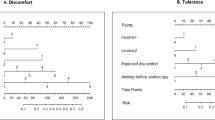Abstract
We aimed to test the reliability of a developed questionnaire that measures and predict aversive endoscopic experience. Two questionnaires (pre- and postprocedure) were given to patients presenting for routine endoscopy. The first questionnaire elicited demographics, prior endoscopic experience, history of drug or alcohol use, patient expectations, and levels of anxiety and nervousness before procedure. After endoscopy, tolerance and willingness to repeat the examination were determined. The primary outcome of “adverse endoscopic experience” (AEE) was defined as a score of ≥5 on the postprocedure overall level of satisfaction or unwillingness to repeat endoscopy. Thirteen of 148 subjects reported an AEE. Items measuring the primary outcome were internally validated by reliability analysis which significantly correlated with measures of aversive experience like pain, nervousness, and suffering during the procedure. Preprocedure factors that were associated with AEE in the univariate analysis and multivariate analysis were nervousness (P = 0.02) and chronic use of psychotropic drugs or alcohol (P = 0.03). In conclusion, we have developed a questionnaire that reliably measures aversive endoscopic experience. Nervousness before procedure and chronic use of psychotropic drugs are reliable predictors of such experience.
Similar content being viewed by others
References
Everhart JE: Overview. In Digestive Diseases in the United States: Epidemiology and Impact. NIH Publication 94–1447. Everhart JE (ed). Bethesda, MD: U.S. Department of Health and Human Services, Public Health Service, National Institutes of Health, 1994, pp 3–53
Froehlich F, Thorens J, Schwizer W, et al.: Sedation and analgesia for colonoscopy: patient tolerance, pain, and cardiorespiratory parameters. Gastrointest Endosc 45:1–9, 1997
Linn LS, Greenfield S: Patient suffering and patient satisfaction among the chronically ill. Med Care20:425–431, 1982
Raymond JM, Michel P, Beyssac R, et al.: Patients opinion following an upper digestive endoscopy in ambulatory care: Results of a national survey (II). Gastroenterol Clin Biol 20:570–574, 1996
Ciriza C, Garcia L, Fernadez A, Diez A, Delgado M, San Sebastian AI: Sedation for gastrointestinal endoscopy. Analysis of tolerance and complications. Rev Esp Enferm Dig 93(9):587–597, 200X
Schutz Sm, Lee LG, Scmitt Cm, Almon M, Baillie J: Clues to patient dissatisfaction with conscious sedation for colonoscopy. Am J Gastro 98(9):1476–1483, 1994
Waye JD: Perspectives. “International Editorial Board.” Gastrointest Endosc 50(6):889–890, 1999
Ware JE, Snyder MK, Wright WR: Development and Validation of Scale to Measure Patient Satisfaction with Health Care Services, Vol 1, Part B. Springfield, VA, National Technical Information, 1998
Linder-Pelz S: Social psychological determinants of patient satisfaction: A test of five hypotheses. Soc Sci Med 15:583–589, 1982
Greenley JR, Young TB, Schoenheor RA: Psychological distress and patient satisfaction.
Morgan I, Roufeil L, Kaushik S, Bassett M: Influence of coping style and pre-colonoscopy information on pain and anxiety of colonoscopy. Gastrointest Endosc 48(2):119–127, 1998
Yacavone RF, Locke GR, Gostout CJ, Rockwood TH, Thieling S, Zinsmeister AR: Factors influencing patient satisfaction with GI endoscopy. Gastrointest Endosc 53(7):703–710, 2001
Davis MS: Variation in patients compliance with doctors orders: Medical practice and doctor–patient interaction. Psychiatr Med 2:31–54, 1971
Davis AR, Ware JE, Brook RH, et al.: Consumer acceptance of prepaid and fee for service medical care: Results from a randomized controlled trial. Health Serv Res 21:429–452, 1986
Vacerino JM: Malpractice: The problem in perspective. JAMA 238:861–863, 1977
Kasteleer J, Kane RL, Olson DM, et al.: Issues underlying the prevalence of “doctor-shopping” behavior. J Health Soc Behav 17:328–339, 1976
American Gastroenterological Association: A primer on outcomes research for the gastroenterologist: Report of the American Gastroenterological Association task force on outcomes research. Gastroenterology 109:302–306, 1995
Oppenheim JP: Questionnaire Design, Interviewing and Attitude Measurment. London, St. Martins Press, 1992
Fink A, Kosecoff J: How to Conduct Surveys: A Step-by-Step Guide. Newbury Park, CA, Sage, 1985
Anastasi A, Urbina S: Psychological Testing. Englewood Cliffs, NJ, Prentice Hall, 1997
Wong RCK: The menu of endoscopic sedation, all you can eat, combinations, a la carte, alternative cuisine, or go hungry. Gastrointest Endosc 54(1):122–126, 2001
Author information
Authors and Affiliations
Corresponding author
Rights and permissions
About this article
Cite this article
Peña, L.R., Mardini, H.E. & Nickl, N.J. Development of an Instrument to Assess and Predict Satisfaction and Poor Tolerance Among Patients Undergoing Endoscopic Procedures. Dig Dis Sci 50, 1860–1871 (2005). https://doi.org/10.1007/s10620-005-2952-7
Received:
Accepted:
Issue Date:
DOI: https://doi.org/10.1007/s10620-005-2952-7




